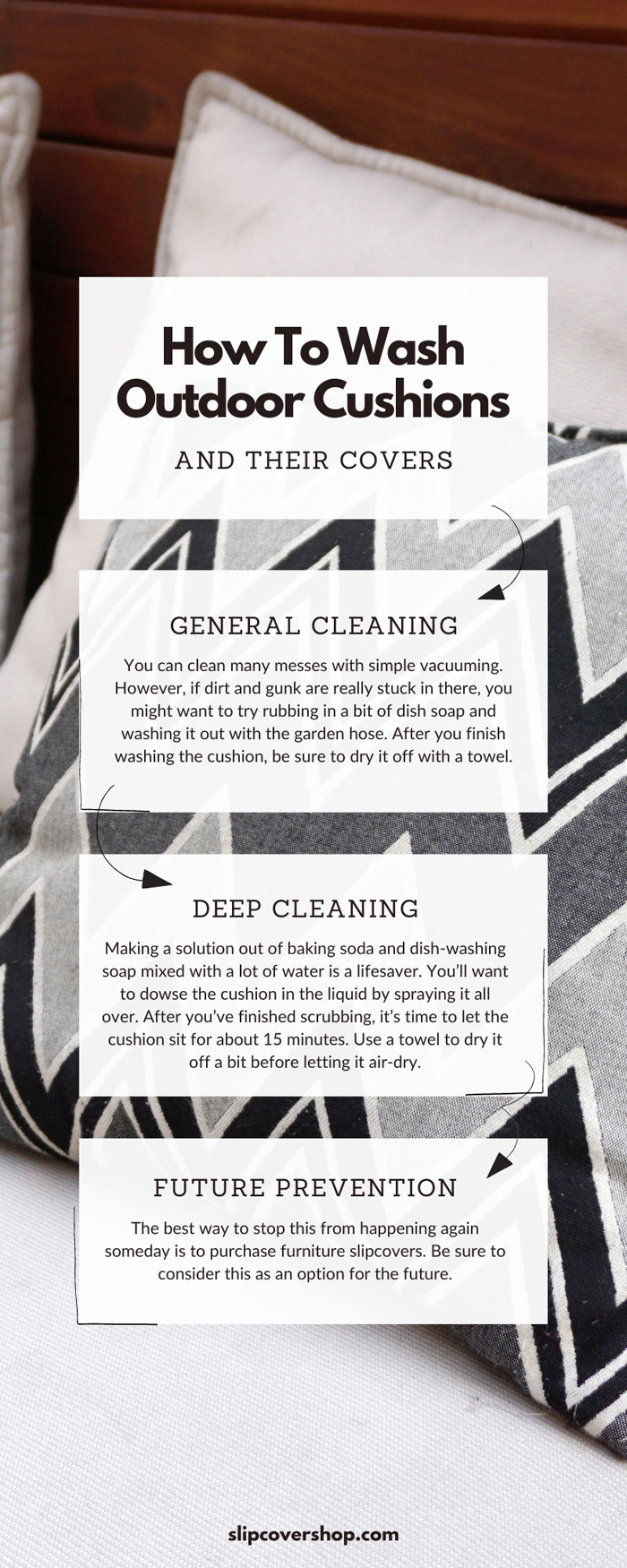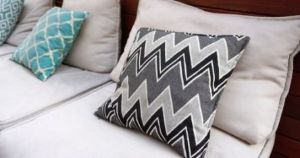Outdoor furniture is a common purchase for people who like to throw many cookout parties. It’s nice to have seating for all your guests without having to bring furniture outside. However, having outdoor furniture means it is way more likely to get dirty, especially if you have cushions on them. If you’re unsure of how to wash outdoor cushion covers or even the cushions themselves, then we’ve got you covered. We’ll go over some general cleaning techniques as well as ones that are best for more specific situations. Hopefully, one of these suggestions will help get rid of those nasty stains.
General Cleaning
When it comes to most messes, you don’t need to do anything drastic. You can clean many messes with simple vacuuming. This will remove any loose dirt or crumbs that got left behind from whoever sat on it last. If you have any hose attachments, those would be the best to use since they can reach deep into crevasses and suck out debris. However, if dirt and gunk are really stuck in there, you might want to try rubbing in a bit of dish soap and washing it out with the garden hose. Just make sure you don’t pressure wash it because that can wear out the fabric, making it go bad before it typically would have. After you finish washing the cushion, be sure to dry it off with a towel. This won’t clean all the water off, but it helps make the air-drying process easier. In order to get the best results for air-drying, you should set it up so the cushion doesn’t come into a lot of contact with other surfaces. Failing to do so will lead to mold and mildew. However, we will cover how to get rid of that later in this article.
Spot Cleaning
Sometimes, general cleaning just isn’t enough for tough stains. That’s when you need to bring out the heavy-duty stuff. Making a solution out of baking soda and dish-washing soap mixed with a lot of water is a lifesaver in situations like this. Put all the contents into a spray bottle and spritz the stain with it. Let it sit for a bit, then proceed to blot it with a towel. Don’t rub it in! This will force the stain further into the cushion, making it harder to get out. After you’ve picked up most of the contents of the stain, let it soak for about 15 minutes this time. This should allow the solution to break up whatever is left. Once the time is up, rinse off the cushion with cold water and let it air-dry the same way we explained in the general cleaning section. Whether you use our concoction to clean your cushions or a cleaning product that you’ve bought, it’s a good idea to see how the solution reacts with your fabric. It could fade the color or possibly even something a little more extreme. Before tackling the spot, find a discrete section of the cushion that no one will notice to test it on and see how it handles it.
Deep Cleaning
Despite your best efforts, there are times when the dirtiness of your cushions exceeds your ability to spot clean it, especially if something drastic got it filthy all at once. It’s time for a deep cleaning, which will combine the strategies from the previous two points. You’ll want to start with the vacuum to get all the loose stuff off the cushions. Be sure to get into all the nooks and crannies! Then you’ll want to pull out the mixture we told you about in the spot cleaning section or some other commercially available deep cleaning solution. You’ll want to dowse the cushion in the liquid by spraying it all over. Once you’ve done that and let it soak in for a few seconds, it’s time to get scrubbing. It’s ok to do this as opposed to dabbing since the dirt is already deep into the cushion, but make sure you do it gently. After you’ve finished scrubbing, it’s time to let the cushion sit for about 15 minutes. Depending on how filthy it was, you might need to go for round two after this soak. If that’s the case, you’ll want to go back to dabbing at it with a cloth after spraying some more solution on the tougher stains. Since most of the cushion is cleaner now, you don’t want to spread the dirt around too much. Repeat this process as needed. Once it’s clean, or at least as clean as it’s going to get, it’s time to rinse it off with a hose. Use a towel to dry it off a bit before letting it air-dry. Since this was a deep clean, you’ll want to make sure the cushion is dry to avoid the growth of any mold and mildew in the future.
Mold and Mildew Stains
So, what do you do if you get either of these issues? First of all, don’t feel bad about it. Mold and mildew usually forms on most outdoor objects due to rain and humidity. Second, it’s time to brew up a new cleaning solution. This one doesn’t use any dish soap, though. Only water and baking soda, although you can use borax if you’re looking for something a little stronger. Start by blotting at the spots with the solution using a towel. Once you’ve attacked all the troublesome areas, let it sit for up to 30 minutes. After it’s done soaking, use a different towel to dab at the mold and mildew locations again. Then go through the standard process of rinsing and air-drying.
Oil and Grease Stains
These two satins require a vastly different form of cleaning. As soon as the spill happens, you’ll want to put cornstarch on the oil or grease. Let it sit for a few minutes to soak it all up, then scrape it back off with a straight-edged object like a shovel. This should do the trick, but feel free to repeat it as needed until the stain is all gone.
Bird Dropping Stains
We know the instinct is to simply throw out a cushion that has bird droppings all over it. However, this is very much a fixable problem. The process is very similar to a regular spot cleaning since it uses the same solution, only this time, you’ll want to use a soft bristle brush instead of a towel. This will allow you to loosen up more of the excrement. You’ll also want to let it soak for longer, but you can get away with 15 minutes if needed. Then the rinsing and drying are the same as before.
Future Prevention
The best way to stop this from happening again someday is to purchase furniture slipcovers, like the ones we offer online. If you’re wondering, the only tip on how to wash outdoor cushion covers is to throw them in the washer—it’s that simple. Be sure to consider this as an option for the future. 

